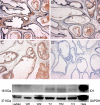Probasin promoter-driven expression of ID1 is not sufficient for carcinogenesis in rodent prostate
- PMID: 19255251
- PMCID: PMC2690411
- DOI: 10.1369/jhc.2009.953182
Probasin promoter-driven expression of ID1 is not sufficient for carcinogenesis in rodent prostate
Abstract
Inhibitor of DNA-binding-1 (ID1) negatively regulates cell differentiation and senescence, and enhances cellular proliferation and angiogenesis. Elevated levels of ID1 have been found in a variety of cancers, including prostate cancer, but whether ID1 has a tumourigenic role remains to be established. We established heterozygous and homozygous ID1-transgenic mouse lines driven by the prostate-specific probasin promoter (-426 to +28 bp). Although elevated levels of ID1 were confirmed by RT-PCR, immunohistochemistry, and Western blot analysis, there were no morphological changes identified in the prostate of transgenic mice at 26 and 52 weeks. Thus, overexpression of ID1 alone is not sufficient to drive neoplastic change in mouse prostate.
Figures





Similar articles
-
A probasin-large T antigen transgenic mouse line develops prostate adenocarcinoma and neuroendocrine carcinoma with metastatic potential.Cancer Res. 2001 Mar 1;61(5):2239-49. Cancer Res. 2001. PMID: 11280793
-
Inhibitor of DNA binding-1 overexpression in prostate cancer: relevance to tumor differentiation.Pathol Oncol Res. 2009 Mar;15(1):91-6. doi: 10.1007/s12253-008-9096-y. Epub 2008 Aug 28. Pathol Oncol Res. 2009. PMID: 18752043
-
ETV4 promotes late development of prostatic intraepithelial neoplasia and cell proliferation through direct and p53-mediated downregulation of p21.J Hematol Oncol. 2020 Aug 13;13(1):112. doi: 10.1186/s13045-020-00943-w. J Hematol Oncol. 2020. PMID: 32791988 Free PMC article.
-
Downregulation of Id1 by small interfering RNA in prostate cancer PC3 cells in vivo and in vitro.Eur J Cancer Prev. 2011 Jan;20(1):9-17. doi: 10.1097/CEJ.0b013e32833ebaa0. Eur J Cancer Prev. 2011. PMID: 20881502
-
Androgen action during prostate carcinogenesis.Methods Mol Biol. 2011;776:25-44. doi: 10.1007/978-1-61779-243-4_2. Methods Mol Biol. 2011. PMID: 21796518 Review.
Cited by
-
Redefining the expression and function of the inhibitor of differentiation 1 in mammary gland development.PLoS One. 2010 Aug 3;5(8):e11947. doi: 10.1371/journal.pone.0011947. PLoS One. 2010. PMID: 20689821 Free PMC article.
-
Inhibitor of Differentiation 1 (Id1) in Cancer and Cancer Therapy.Int J Med Sci. 2020 Apr 6;17(8):995-1005. doi: 10.7150/ijms.42805. eCollection 2020. Int J Med Sci. 2020. PMID: 32410828 Free PMC article. Review.
-
Id1 overexpression is independent of repression and epigenetic silencing of tumor suppressor genes in melanoma.Epigenetics. 2010 Jul 1;5(5):410-21. doi: 10.4161/epi.5.5.11929. Epub 2010 Jul 1. Epigenetics. 2010. PMID: 20484992 Free PMC article.
-
The ID proteins: master regulators of cancer stem cells and tumour aggressiveness.Nat Rev Cancer. 2014 Feb;14(2):77-91. doi: 10.1038/nrc3638. Epub 2014 Jan 20. Nat Rev Cancer. 2014. PMID: 24442143 Review.
References
-
- Benezra R, Rafii S, Lyden D (2001) The Id proteins and angiogenesis. Oncogene 20:8334–8341 - PubMed
-
- Greenberg NM, DeMayo FJ, Sheppard PC, Barrios R, Lebovitz R, Finegold M, Angelopoulou R, et al. (1994) The rat probasin gene promoter directs hormonally and developmentally regulated expression of a heterologous gene specifically to the prostate in transgenic mice. Mol Endocrinol 8:230–239 - PubMed
Publication types
MeSH terms
Substances
LinkOut - more resources
Full Text Sources
Medical
Molecular Biology Databases

